
Kranjska Gora is a town in northwestern Slovenia, on the Sava Dolinka River in the Upper Carniola region, close to the Austrian and Italian borders. It is the seat of the Municipality of Kranjska Gora. The tripoint between Austria, Italy and Slovenia lies on the mountain of Dreiländereck, known as Peč in Slovenia.
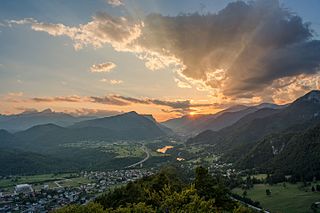
Jesenice is the tenth-largest town in Slovenia, located in the traditional province of Upper Carniola. It is the seat of the Municipality of Jesenice spanning the southern side of the Karawanks, along Slovenia's border with Austria to the north. Renowned as a mining town, its ironworks and metallurgy industries being the driving force of the town's historical development.
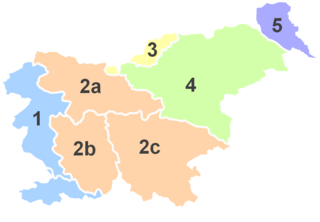
Upper Carniola is a traditional region of Slovenia, the northern mountainous part of the larger Carniola region. The largest town in the region is Kranj, and other urban centers include Kamnik, Jesenice, Domžale and Škofja Loka. It has around 300,000 inhabitants or 14% of the population of Slovenia.

The Sava Dolinka is a headwater of the Sava River in northwestern Slovenia. The 45 kilometres (28 mi) long Sava Dolinka starts as Nadiža Creek in the Planica Valley under Mount Zadnja Ponca in the Julian Alps, at an elevation of 1222 m, close to the Italian border. The stream goes underground soon after its source and breaks out again after 5 km at an elevation of 842 m in Zelenci, near Kranjska Gora. The Sava Dolinka flows through Kranjska Gora, Gozd Martuljek, Jesenice, between Bled and Breg, and past the town of Lesce. The first in a series of hydroelectric power plants on the river, the Moste Hydro Power Plant, is located near Žirovnica. It merges with the second major headwater of the Sava, the Sava Bohinjka, at Radovljica. Tributaries of the Sava Dolinka include the Triglav Bistrica at Mojstrana and the Radovna, which flows through the Vintgar Gorge near Bled.
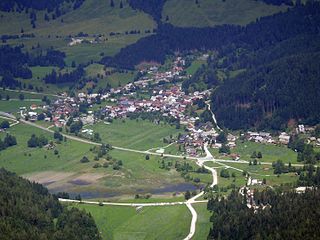
Rateče is a village in the Municipality of Kranjska Gora, in the far northwest corner of Slovenia. It is located in the upper part of the Upper Sava Valley, between the Sava Dolinka and Ziljica rivers, a tributary of the Drava. Further up the valley is the Rateče border crossing to Italy. Rateče is the closest Slovenian village to the summit of Mount Peč, the point where the borders of Austria, Italy, and Slovenia meet.

St. Thomas's Church in Rateče, Kranjska Gora, Slovenia, is one of the oldest churches in the upper Sava Valley, confirmed by written documents and excavations as well as the church's original furnishings.

Planina pod Golico is a mountain village in the Municipality of Jesenice, in the Upper Carniola region of Slovenia. It lies on the southern foot of Mount Golica in the Karawanks range, at an elevation of 954 metres (3,130 ft).

Mojstrana is a village in the Municipality of Kranjska Gora in the Upper Carniola region of Slovenia.

The Upper Sava Valley is an alpine valley in the Upper Carniola region of Slovenia. The Sava Dolinka River flows along it. It begins in Rateče at an elevation of 870 m and ends at Moste at 560 m. It is the geographical border between the Julian Alps and the Karawanks. It was created on a tectonic fault that runs down the middle of the valley. Its geomorphological forms are a result of the actions of the river and glaciers. A number of smaller valleys lead into it from both sides.
Slovenski Javornik is a settlement in the Municipality of Jesenice in the Upper Carniola region of Slovenia. Commonly known simply as Javornik, the place name is derived from the Slovene word javor 'maple'.

The Kos Manor is a 16th-century manor house located in the Murova neighborhood of the town of Jesenice, Slovenia, at the street address of Cesta maršala Tita 64. It is one of four so-called "ironworks castles" built in the area during the 16th and early 17th centuries by owners of local iron-mining and -processing facilities, in what were then the clustered settlements of Plavž, Sava, Murova and Javornik, amalgamated into the town of Jesenice in 1929. The Bucellini-Ruard Manor in Sava is another survivor of the original four; the Plavž and Javornik manors have been torn down.
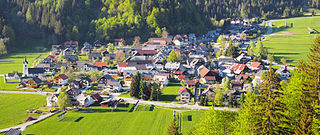
Podkoren is a settlement in the Municipality of Kranjska Gora in the northwestern Upper Carniola region of Slovenia.
Zgornja Radovna is a dispersed settlement in the Municipality of Kranjska Gora, northwestern Slovenia, belonging to the traditional region of Upper Carniola. The village lies at the juncture of the Kot Valley and the northern part of the Krma Valley. The Radovna River, a tributary of the Sava Dolinka, emerges under the Jutrova Skala Slope in the northeastern part of the settlement.
The Liznjek Farm is an ethnographic museum housed in a renovated 18th-century farmhouse, located in the centre of the town of Kranjska Gora, Slovenia, at the street address 63 Borovška cesta. It is administered by the Upper Sava Museum, based in nearby Jesenice. The farm presents the living conditions of a wealthy peasant family of the mid-19th century.

The Workers' Barracks is a historic building at 48 France Prešeren Street in the Stara Sava district of the town of Jesenice, northwestern Slovenia. Formerly a residential block, it now houses an ethnographic museum.

The Bucellini–Ruard Manor, commonly referred to as the Ruard Manor, is a 16th-century manor house located in the Sava neighbourhood of the town of Jesenice in northwestern Slovenia, at the street address of 45 France Prešeren Street. It is one of four so-called "ironworks castles" built in the area during the 16th and early 17th centuries by the owners of iron-mining and -processing facilities, in what were then the clustered settlements of Plavž, Sava, Murova and Javornik, amalgamated into the town of Jesenice in 1929. The Kos Manor in Murova also survives; the Plavž and Javornik manors were demolished.
The Kajžnk House or Kajžnik House is an ethnographic museum in a restored Alpine farmhouse in the village of Rateče, in the northwest Slovenian Municipality of Kranjska Gora.

Weissenfels Castle is a castle ruin above the settlement of Fusine in Valromana in the extreme northeast corner of Italy. The ruins are located 5.7 kilometers (3.5 mi) from the tripoint between Slovenia, Austria, and Italy.
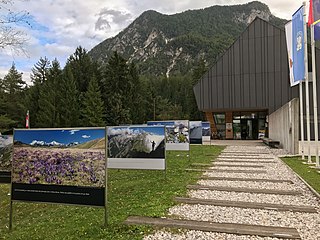
The Slovenian Alpine Museum is a mountaineering museum in Mojstrana in the vicinity of Triglav National Park in northwestern Slovenia. It was opened on 7 August 2010 by the president of Slovenia, Danilo Türk. It is operated by the Jesenice Upper Sava Museum. In June 2016, the Swiss King Albert I Memorial Foundation bestowed it the Albert Mountain Award for its important contribution to the sustainable development of the Alpine space.

The Municipality of Kranjska Gora is a municipality on the Sava Dolinka River in the Upper Carniola region of northwest Slovenia, close to the Austrian and Italian borders. The seat of the municipality is the town of Kranjska Gora. It borders Italy & Austria.


















